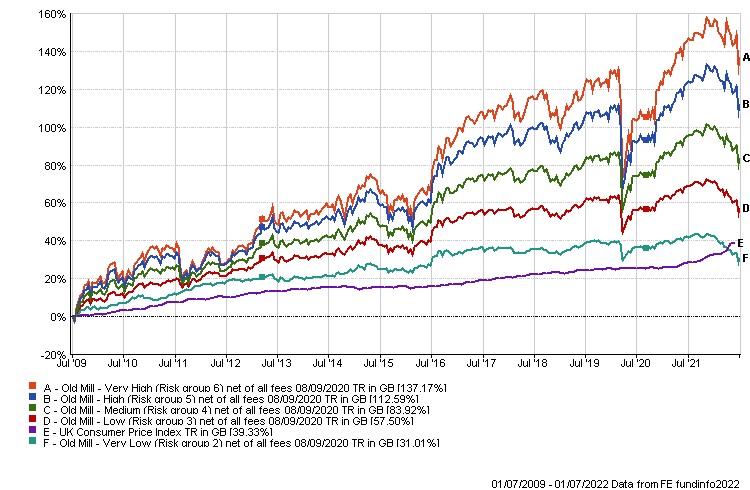Investing is for the long term
At times like this when our news is often filled with much doom and gloom, we should remember the long-term nature of investing and view the returns we are currently seeing from that perspective.
20th July 2022
-
Gavin Jones See profile
For most investors, the accumulation of wealth is a slow process as money is put aside into pensions and ISAs, inheritances are invested, or the proceeds of asset disposals are put to work in the markets.
This multiple decade journey to a level of wealth that provides choice, freedom, and financial security, is punctuated by moments of market turmoil that can lead to temporary falls in portfolio values. When accumulating wealth, such falls provide the opportunity to buy equities at lower prices and with higher expected returns. Income from employment provides a sense of security and, for some, surplus cash flow to accelerate contributions to the retirement pot. Alternatively, options remain for some to retire later, or to work part-time.
When workplace income stops, and your accumulated wealth takes over the role of providing cashflow to fund lifestyles, it is entirely understandable that falls in portfolio values may make some investors feel a little bit uncomfortable. It is helpful to remember that as part of the financial planning process, the financial capacity to suffer losses is considered to test the suitability of the portfolio chosen to meet a client’s financial goals.
Regular meetings with your Financial Planner also provide updates on how the plan is performing against its target and the opportunity to talk through any areas of concern and, if necessary, to make adjustments to ensure the plan stays on course.
As part of this analysis, financial planners will be fully aware that investing is a three-steps-forward, one-step-back type of process and will strive to help clients to understand the nature of the journey they face. However, when markets fall, much of this can be momentarily forgotten. There will be times when portfolio returns are well ahead of inflation, and others when they are not, as the chart below illustrates. This shows the year by year returns for a typical (not Old Mill) portfolio invested 60% in global equities and 40% in short-dated global bonds. We would consider this to be a higher risk portfolio.
Figure 1: Calendar year, after inflation returns plus YTD 30 April 2022 (latest Consumer Price Index data)

Source: Morningstar Direct © All rights reserved.
The first point of note is that despite all of the ‘bad’ news, portfolio returns in 2022 are not as bad as some might have imagined, helped by broad diversification and, to some extent, by the weakness of Sterling (overseas assets are now worth more priced in Sterling terms). Outcomes in 2022 still sit well within normal expectations. In fact, a 60% global equity, 40% global bond portfolio could in theory fall by as much as 30% and still be within the bounds of expectation.
The chart below plots the returns of such a portfolio (the same structure as above) but before inflation. It also plots the cumulative UK CPI inflation index for comparison. Inevitably there will be times when portfolios deliver returns below inflation, but over time, the purchasing power of wealth is expected to grow. Despite the market setbacks of 2000-2003, 2007-2009, Covid in 2020 and today’s market reversal, the purchasing power of invested wealth has grown considerably. £1 invested in January 1999 is now worth £3.70. Growth of 270% against rise in inflation over the period of 67%.
Figure 2: Growth of £1 compared to inflation

Source: Morningstar Direct © All rights reserved.
It is helpful at times like these to remember that spending wealth in retirement is also a slow process too, similar to its accumulation. Imagine that the withdrawal rate from a portfolio is 3% of its starting value per year adjusted for inflation (i.e., £30,000 on an initial £1 million invested). A couple of years of returns below inflation, is going to make very little impact on portfolio outcomes over a 20- or 30-year (or more) retirement horizon. There should be plenty of years ahead when portfolio returns will be above inflation. Even if there are not, the annual planning process will provide the opportunity to adjust future plans in a calm and informed manner. Those who have been invested over the past few years will already have accumulated strong growth in the purchasing power of their portfolio, providing a solid financial buffer against future periods of higher inflation like those we are experiencing at present.
Investors are well served by measuring the value of their wealth against their long-term plan, not against the latest high-water mark of the markets. Portfolio values are still materially above where they were a couple of years ago, even when measured from pre-Covid levels in 2020, as the chart above clearly shows. We have been asked how long it may take for portfolios to recover from this latest wobble and the truth is we don’t know. Previous falls have had a wide range of timescales ranging from months to a number of years. A recent piece of research[1] revealed that, on average (as ever, no guarantee), returns following market falls tend to be quite strong, historically delivering a cumulative 50% rise in value over the subsequent five years in the case of the US after a 30% fall. Investing is a slow process that rewards patience and fortitude and is not something that should be rushed.
We started investing with in line with our current investment philosophy at the beginning of July 2009. Since then, a medium risk portfolio has grown by 4.8% a year net of all fees. The performance of all portfolios is shown in the table and graph below.
Figure 3: Average annual return of standard portfolios

Figure 4: 13-year performance of standard portfolios (from 1 July 2009 to 1 July 2022)

[1] https://my.dimensional.com/three-crucial-lessons-for-weathering-the-stock-markets-storm

